engine TOYOTA GR YARIS 2022 Owners Manual
[x] Cancel search | Manufacturer: TOYOTA, Model Year: 2022, Model line: GR YARIS, Model: TOYOTA GR YARIS 2022Pages: 470, PDF Size: 113.17 MB
Page 273 of 470
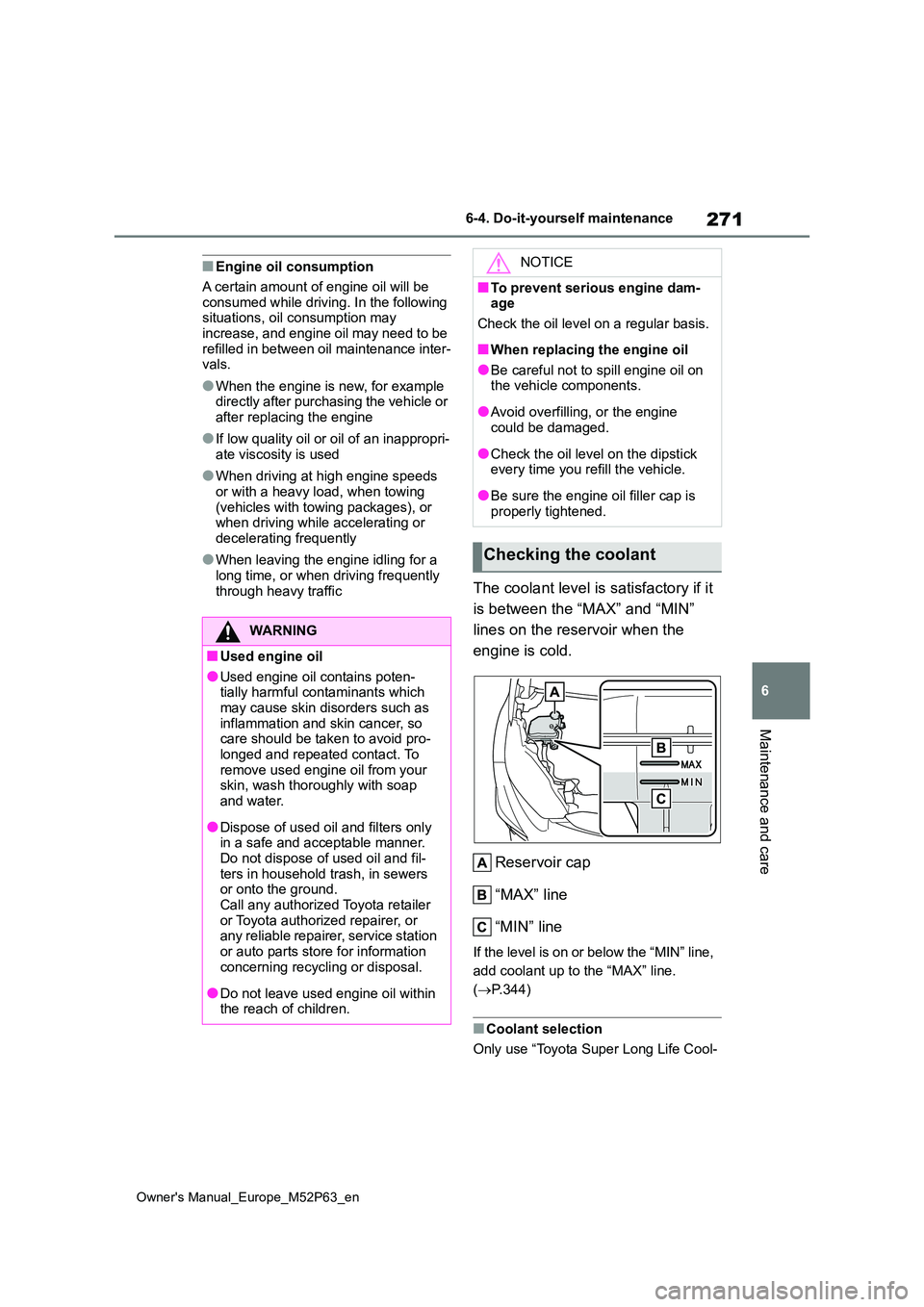
271
6
Owner's Manual_Europe_M52P63_en
6-4. Do-it-yourself maintenance
Maintenance and care
■Engine oil consumption
A certain amount of engine oil will be
consumed while driving. In the following situations, oil consumption may increase, and engine oil may need to be
refilled in between oil maintenance inter- vals.
●When the engine is new, for example directly after purchasing the vehicle or after replacing the engine
●If low quality oil or oil of an inappropri-ate viscosity is used
●When driving at high engine speeds or with a heavy load, when towing
(vehicles with towing packages), or when driving while accelerating or decelerating frequently
●When leaving the engine idling for a long time, or when driving frequently
through heavy trafficThe coolant level is satisfactory if it
is between the “MAX” and “MIN”
lines on the reservoir when the
engine is cold.
Reservoir cap
“MAX” line
“MIN” line
If the level is on or below the “MIN” line,
add coolant up to the “MAX” line.
( P.344)
■Coolant selection
Only use “Toyota Super Long Life Cool-
WARNING
■Used engine oil
●Used engine oil contains poten- tially harmful contaminants which may cause skin disorders such as
inflammation and skin cancer, so care should be taken to avoid pro-longed and repeated contact. To
remove used engine oil from your skin, wash thoroughly with soap and water.
●Dispose of used oil and filters only in a safe and acceptable manner.
Do not dispose of used oil and fil- ters in household trash, in sewers or onto the ground.
Call any authorized Toyota retailer or Toyota authorized repairer, or any reliable repairer, service station
or auto parts store for information concerning recycling or disposal.
●Do not leave used engine oil within the reach of children.
NOTICE
■To prevent serious engine dam-age
Check the oil level on a regular basis.
■When replacing the engine oil
●Be careful not to spill engine oil on the vehicle components.
●Avoid overfilling, or the engine could be damaged.
●Check the oil level on the dipstick every time you refill the vehicle.
●Be sure the engine oil filler cap is properly tightened.
Checking the coolant
Page 274 of 470
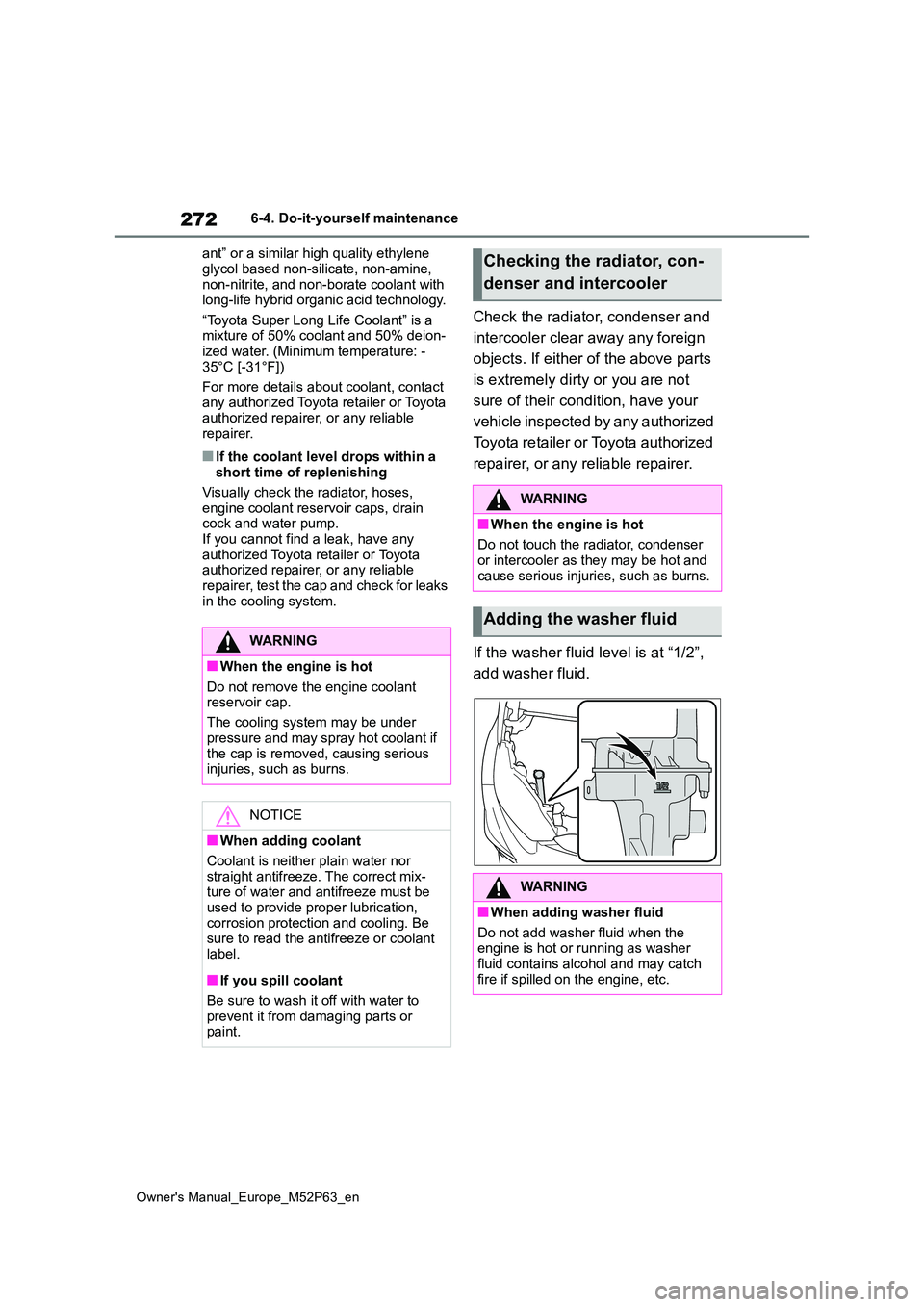
272
Owner's Manual_Europe_M52P63_en
6-4. Do-it-yourself maintenance
ant” or a similar high quality ethylene
glycol based non-silicate, non-amine, non-nitrite, and non-borate coolant with long-life hybrid organic acid technology.
“Toyota Super Long Life Coolant” is a mixture of 50% coolant and 50% deion-ized water. (Minimum temperature: -
35°C [-31°F])
For more details about coolant, contact any authorized Toyota retailer or Toyota
authorized repairer, or any reliable repairer.
■If the coolant level drops within a short time of replenishing
Visually check the radiator, hoses, engine coolant reservoir caps, drain cock and water pump.
If you cannot find a leak, have any authorized Toyota retailer or Toyota authorized repairer, or any reliable
repairer, test the cap and check for leaks in the cooling system.
Check the radiator, condenser and
intercooler clear away any foreign
objects. If either of the above parts
is extremely dirty or you are not
sure of their condition, have your
vehicle inspected by any authorized
Toyota retailer or Toyota authorized
repairer, or any reliable repairer.
If the washer fluid level is at “1/2”,
add washer fluid.
WARNING
■When the engine is hot
Do not remove the engine coolant reservoir cap.
The cooling system may be under
pressure and may spray hot coolant if the cap is removed, causing serious injuries, such as burns.
NOTICE
■When adding coolant
Coolant is neither plain water nor straight antifreeze. The correct mix-ture of water and antifreeze must be
used to provide proper lubrication, corrosion protection and cooling. Be sure to read the antifreeze or coolant
label.
■If you spill coolant
Be sure to wash it off with water to prevent it from damaging parts or paint.
Checking the radiator, con-
denser and intercooler
WARNING
■When the engine is hot
Do not touch the radiator, condenser
or intercooler as they may be hot and cause serious injuries, such as burns.
Adding the washer fluid
WARNING
■When adding washer fluid
Do not add washer fluid when the engine is hot or running as washer fluid contains alcohol and may catch
fire if spilled on the engine, etc.
Page 275 of 470
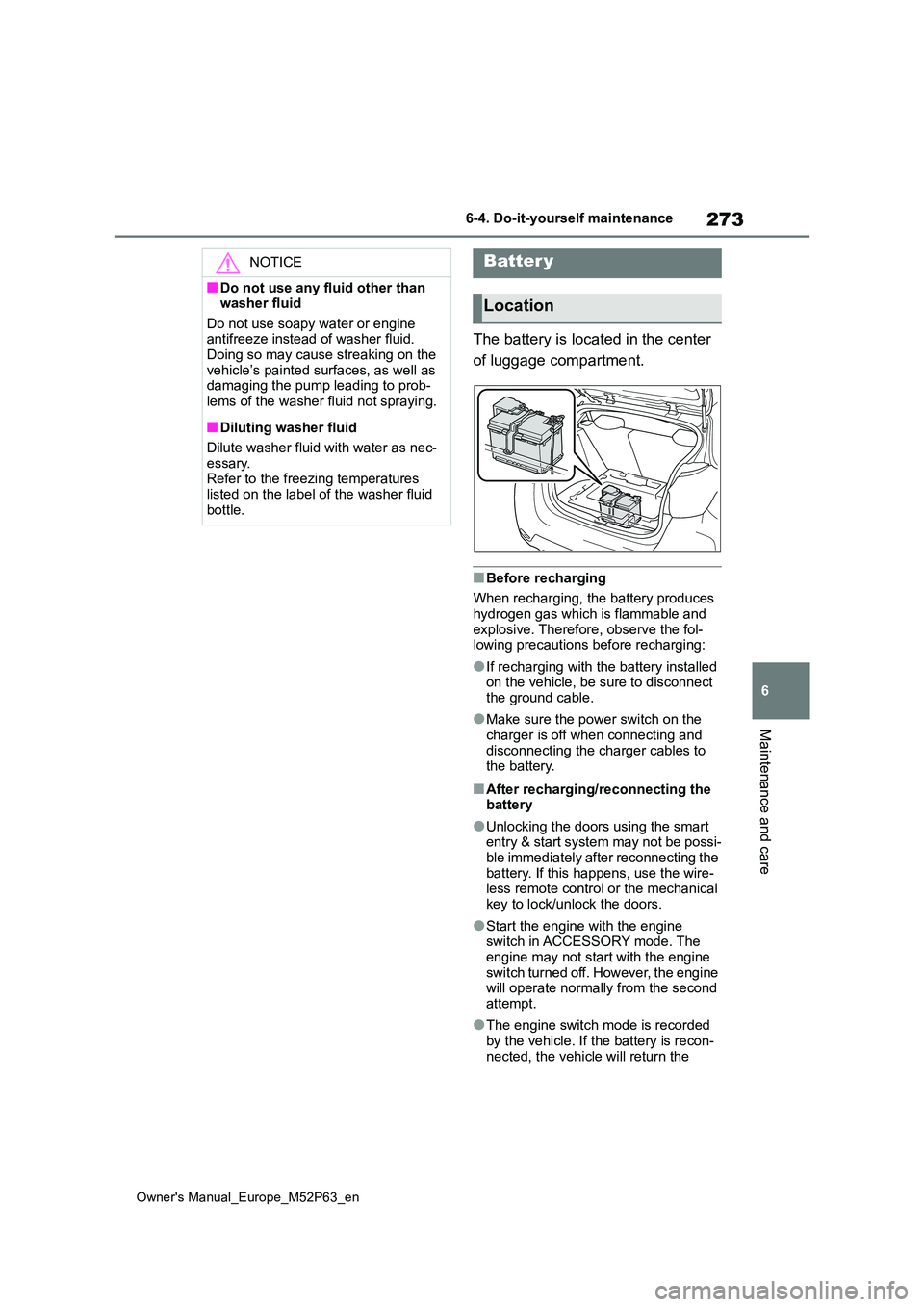
273
6
Owner's Manual_Europe_M52P63_en
6-4. Do-it-yourself maintenance
Maintenance and care
The battery is located in the center
of luggage compartment.
■Before recharging
When recharging, the battery produces hydrogen gas which is flammable and
explosive. Therefore, observe the fol- lowing precautions before recharging:
●If recharging with the battery installed on the vehicle, be sure to disconnect the ground cable.
●Make sure the power switch on the charger is off when connecting and
disconnecting the charger cables to the battery.
■After recharging/reconnecting the battery
●Unlocking the doors using the smart entry & start system may not be possi-
ble immediately after reconnecting the battery. If this happens, use the wire-less remote control or the mechanical
key to lock/unlock the doors.
●Start the engine with the engine switch in ACCESSORY mode. The engine may not start with the engine
switch turned off. However, the engine will operate normally from the second attempt.
●The engine switch mode is recorded by the vehicle. If the battery is recon-
nected, the vehicle will return the
NOTICE
■Do not use any fluid other than washer fluid
Do not use soapy water or engine antifreeze instead of washer fluid.Doing so may cause streaking on the
vehicle’s painted surfaces, as well as damaging the pump leading to prob-lems of the washer fluid not spraying.
■Diluting washer fluid
Dilute washer fluid with water as nec-
essary. Refer to the freezing temperatures listed on the label of the washer fluid
bottle.
Batter y
Location
Page 276 of 470
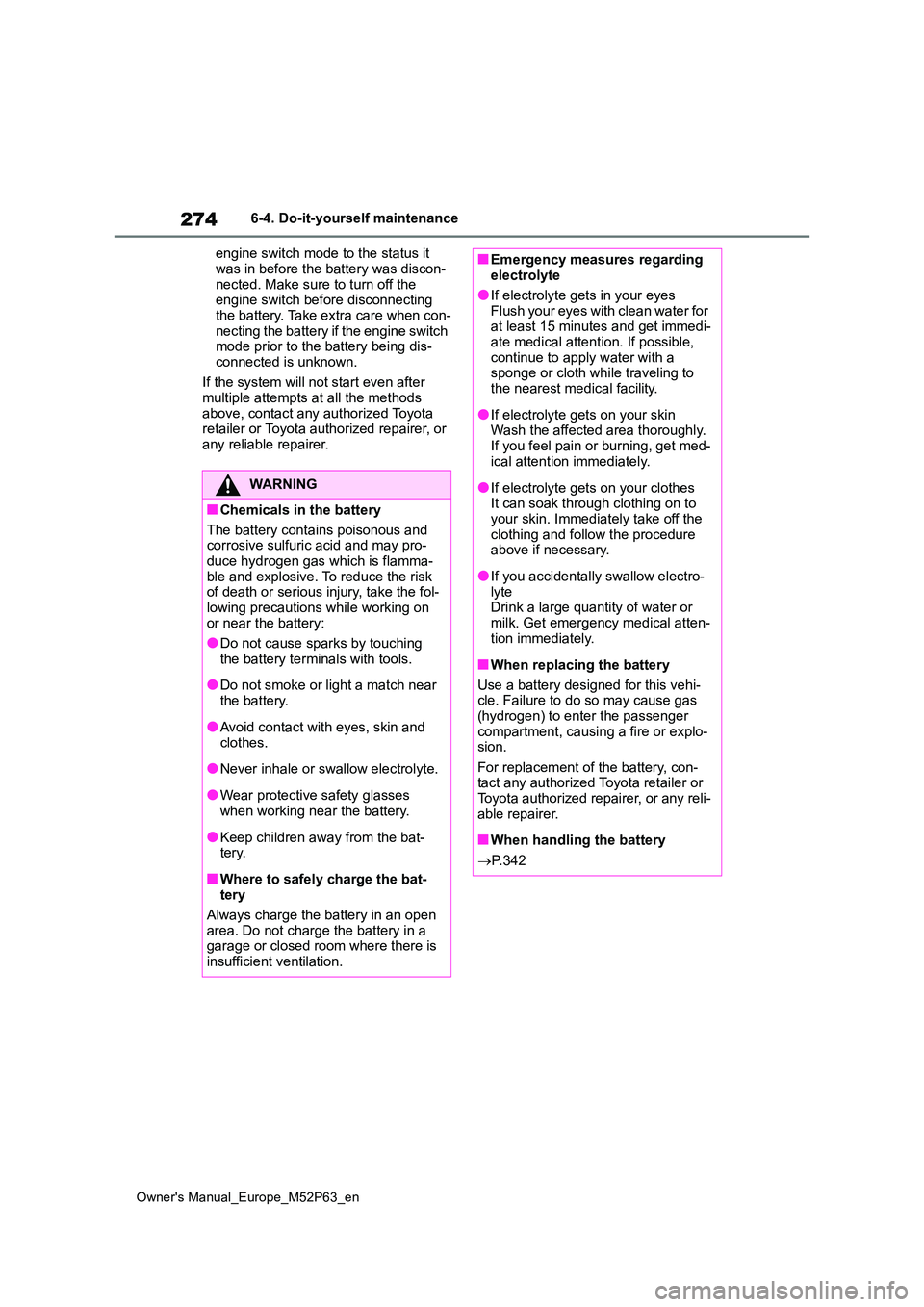
274
Owner's Manual_Europe_M52P63_en
6-4. Do-it-yourself maintenance
engine switch mode to the status it
was in before the battery was discon- nected. Make sure to turn off the engine switch before disconnecting
the battery. Take extra care when con- necting the battery if the engine switch mode prior to the battery being dis-
connected is unknown.
If the system will not start even after multiple attempts at all the methods
above, contact any authorized Toyota retailer or Toyota authorized repairer, or any reliable repairer.
WARNING
■Chemicals in the battery
The battery contains poisonous and corrosive sulfuric acid and may pro-
duce hydrogen gas which is flamma- ble and explosive. To reduce the risk of death or serious injury, take the fol-
lowing precautions while working on or near the battery:
●Do not cause sparks by touching
the battery terminals with tools.
●Do not smoke or light a match near
the battery.
●Avoid contact with eyes, skin and
clothes.
●Never inhale or swallow electrolyte.
●Wear protective safety glasses when working near the battery.
●Keep children away from the bat-tery.
■Where to safely charge the bat-tery
Always charge the battery in an open area. Do not charge the battery in a garage or closed room where there is
insufficient ventilation.
■Emergency measures regarding electrolyte
●If electrolyte gets in your eyes
Flush your eyes with clean water for at least 15 minutes and get immedi-ate medical attention. If possible,
continue to apply water with a sponge or cloth while traveling to the nearest medical facility.
●If electrolyte gets on your skinWash the affected area thoroughly.
If you feel pain or burning, get med- ical attention immediately.
●If electrolyte gets on your clothesIt can soak through clothing on to your skin. Immediately take off the
clothing and follow the procedure above if necessary.
●If you accidentally swallow electro-lyteDrink a large quantity of water or
milk. Get emergency medical atten- tion immediately.
■When replacing the battery
Use a battery designed for this vehi- cle. Failure to do so may cause gas
(hydrogen) to enter the passenger compartment, causing a fire or explo-sion.
For replacement of the battery, con- tact any authorized Toyota retailer or Toyota authorized repairer, or any reli-
able repairer.
■When handling the battery
P. 3 4 2
Page 277 of 470
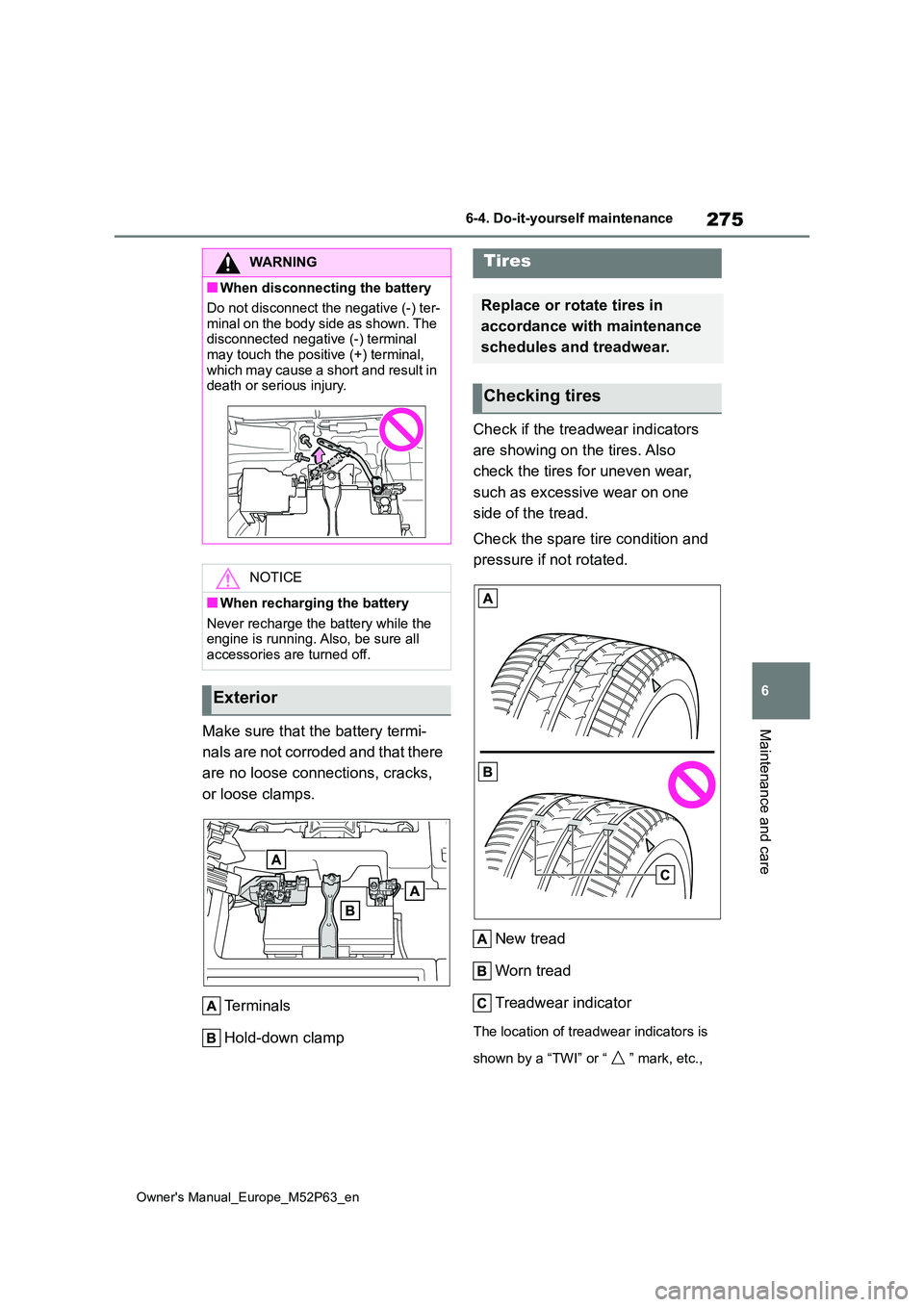
275
6
Owner's Manual_Europe_M52P63_en
6-4. Do-it-yourself maintenance
Maintenance and careMake sure that the battery termi-
nals are not corroded and that there
are no loose connections, cracks,
or loose clamps.
Terminals
Hold-down clamp
Check if the treadwear indicators
are showing on the tires. Also
check the tires for uneven wear,
such as excessive wear on one
side of the tread.
Check the spare tire condition and
pressure if not rotated.
New tread
Worn tread
Treadwear indicator
The location of treadwear indicators is
shown by a “TWI” or “ ” mark, etc.,
WARNING
■When disconnecting the battery
Do not disconnect the negative (-) ter-
minal on the body side as shown. The disconnected negative (-) terminal may touch the positive (+) terminal,
which may cause a short and result in death or serious injury.
NOTICE
■When recharging the battery
Never recharge the battery while the engine is running. Also, be sure all accessories are turned off.
Exterior
Tires
Replace or rotate tires in
accordance with maintenance
schedules and treadwear.
Checking tires
Page 280 of 470

278
Owner's Manual_Europe_M52P63_en
6-4. Do-it-yourself maintenance
The unit can be changed.
■How to change the unit
1 Park the vehicle in a safe place
and turn the engine switch off.
Changing the unit cannot be performed while the vehicle is moving.
2 Turn the engine switch to ON.
3 Press / of the meter con-
trol switch to select .
4 Press / to select “Vehicle
Settings” and then press and
hold .
5 Press / to select “TPWS
setting” and then press .
6 Press / to select “Setting
Unit”.
7 Press / to select the
desired unit and then press .
■Routine tire inflation pressure checks
The tire pressure warning system does not replace routine tire inflation pressure checks. Make sure to check tire inflation
pressure as part of your routine of daily
vehicle checks.
■Tire inflation pressure
●It may take a few minutes to display
the tire inflation pressure after the engine switch is turned to ON. It may also take a few minutes to display the
tire inflation pressure after inflation pressure has been adjusted.
●Tire inflation pressure changes with temperature. The displayed values may also be different from the values
measured using a tire pressure gauge.
■Situations in which the tire pres-sure warning system may not oper-
ate properly
●In the following cases, the tire pres-
sure warning system may not operate properly.• If non-genuine Toyota wheels are
used. • A tire has been replaced with a tire that is not an OE (Original Equipment)
tire. • A tire has been replaced with a tire that is not of the specified size.
• Tire chains, etc. are equipped. • An auxiliary-supported run-flat tire is equipped.
• If a window tint that affects the radio wave signals is installed.• If there is a lot of snow or ice on the
vehicle, particularly around the wheels or wheel housings.• If the tire inflation pressure is
extremely higher than the specified level.• If tires not equipped with tire pressure
warning valves and transmitters are used.• If the ID code on the tire pressure
warning valves and transmitters is not registered in the tire pressure warning computer.
●Performance may be affected in the following situations.
• Near a TV tower, electric power plant, gas station, radio station, large dis-play, airport or other facility that gen-
Page 282 of 470

280
Owner's Manual_Europe_M52P63_en
6-4. Do-it-yourself maintenance
■The tire pressure warning sys-
tem must be init ialized in the
following circumstances:
When rotating front and rear tires
which have different tire inflation
pressures.
When changing the tire size.
When the tire inflation pressure
is changed such as when chang-
ing traveling speed or load
weight.
When changing between two
registered wheel sets.
When the tire pressure warning
system is initialized, the current tire
inflation pressure is set as the
benchmark pressure.
■How to initialize the tire pres-
sure warning system
1 Park the vehicle in a safe place
and turn the engine switch off,
wait for approximately 15 min-
utes or more and perform the
procedure.
2 Adjust the tire inflation pressure
to the specified cold tire inflation
pressure level. ( P.355)
Make sure to adjust the tire pressure to the specified cold tire inflation pressure level. The tire pressure warning system
will operate based on this pressure level.
3 Turn the engine switch to ON.
Initialization cannot be performed while
the vehicle is moving.
4 Press / of the meter con-
trol switch to select .
5 Press / to select “Vehicle
Settings” and then press and
hold .
6 Press / to select “TPWS
setting” and then press .
7 Press / to select “Setting
Pressure”. Then press and hold
until the tire pressure warn-
ing light blinks 3 times.
Then a message will be displayed on the multi-information display. “--” will be displayed on the multi-information dis-
play for the inflation pressure of each tire while initialization is being per-formed.
8 Drive straight (with occasional
left and right turns) at approxi-
mately 40 km/h (25 mph) or
more for approximately 10 to 30
minutes.
Even if the vehicle is not driven at
approximately 40 km/h (25 mph) or more, initialization can be completed by driving for a long time. However, if ini-
Initializing the tire pressure
warning system
Page 283 of 470

281
6
Owner's Manual_Europe_M52P63_en
6-4. Do-it-yourself maintenance
Maintenance and care
tialization does not complete after driv-
ing for 1 hour or more, park the vehicle in a safe place for more than 15 min-utes and please drive a vehicle once
again with the engine switch ON. ( P.283)
■Initialization procedure
●Make sure to carry out initialization
after adjusting the tire inflation pres- sure.Also, make sure the tires are cold
before carrying out initialization or tire inflation pressure adjustment.
●If you have accidentally turned the engine switch off during initialization, it is not necessary to press the reset
switch again as initialization will restart automatically when the engine switch is turned to ON the next time.
●If you accidentally press the reset switch when initialization is not neces-
sary, adjust the tire inflation pressure to the specified level when the tires are cold, and conduct initialization
again.
●While the position of each tire is being
determined and the inflation pres- sures are not being displayed on the multi-information display, if the infla-
tion pressure of a tire drops, the tire pressure warning light will come on.
■If the tire pressure warning system
is not initialized properly
●In the following situations, initialization
may take longer than usual to be com- pleted or may not be possible. (Usu-ally, the vehicle will need to be driven
for approximately 10 to 30 minutes to complete initialization.) If initialization is not complete after driving approxi-
mately 30 minutes, continue driving for a while.• If the vehicle is driven on an unpaved
road, it may take longer to complete initialization.• If the vehicle is backed up while per-
forming initialization, data collected during initialization will be cleared and it will take longer than normal to com-
plete.
• If the vehicle is driven in heavy traffic or another situation where other vehi-cles are driven close by, it may take
time for the system to recognize the tire pressure warning valve and trans-mitters of your vehicle over those of
other vehicles.
If initialization is not complete after driv-
ing for approximately 1 hour, park the
vehicle in a safe place for more than 15
minutes and then drive the vehicle
again.
●In the following situations, initialization
will not be started or was not com- pleted properly and the system will not operate properly. Perform the initial-
ization procedure again. • If, when attempting to start initializa-tion, the tire pressure warning light
does not blink 3 times. • If, when the vehicle has been driven for about 20 minutes after performing
initialization, the tire pressure warning light blinks for approximately 1 minute and then illuminates.
●If initialization cannot be completed after performing the above procedure,
contact any authorized Toyota retailer or Toyota authorized repairer, or any reliable repairer.
The tire pressure warning valve
and transmitter is equipped with a
WARNING
■When initializing the tire pres- sure warning system
Do not initialize the tire pressure
warning system without first adjusting the tire inflation pressure to the speci-fied level. Otherwise, the tire pressure
warning light may not come on even if the tire inflation pressure is low, or it may come on when the tire inflation
pressure is actually normal.
Registering ID codes
Page 284 of 470
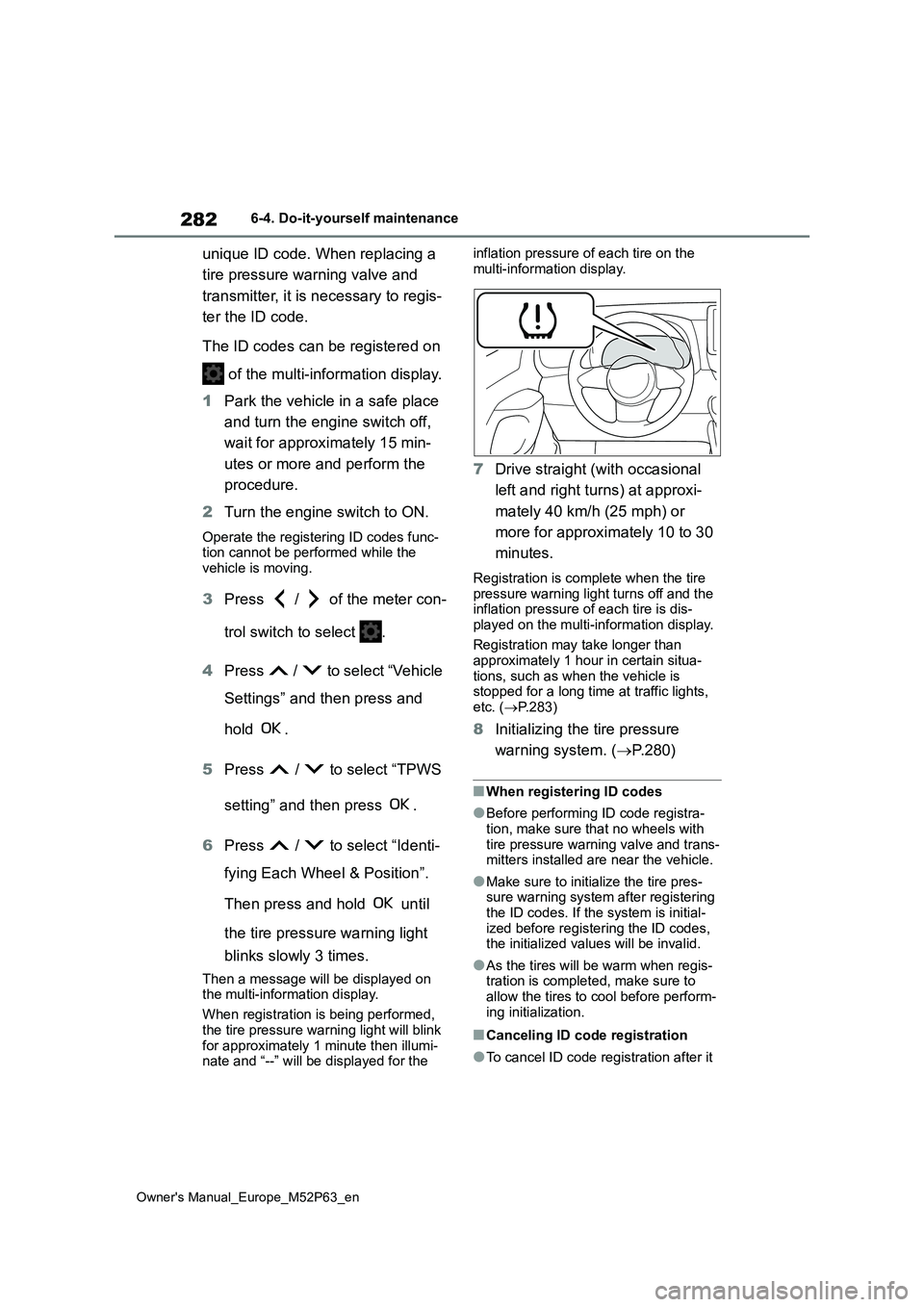
282
Owner's Manual_Europe_M52P63_en
6-4. Do-it-yourself maintenance
unique ID code. When replacing a
tire pressure warning valve and
transmitter, it is necessary to regis-
ter the ID code.
The ID codes can be registered on
of the multi-information display.
1 Park the vehicle in a safe place
and turn the engine switch off,
wait for approximately 15 min-
utes or more and perform the
procedure.
2 Turn the engine switch to ON.
Operate the registering ID codes func- tion cannot be performed while the
vehicle is moving.
3 Press / of the meter con-
trol switch to select .
4 Press / to select “Vehicle
Settings” and then press and
hold .
5 Press / to select “TPWS
setting” and then press .
6 Press / to select “Identi-
fying Each Wheel & Position”.
Then press and hold until
the tire pressure warning light
blinks slowly 3 times.
Then a message will be displayed on the multi-information display.
When registration is being performed,
the tire pressure warning light will blink for approximately 1 minute then illumi-nate and “--” will be displayed for the
inflation pressure of each tire on the
multi-information display.
7 Drive straight (with occasional
left and right turns) at approxi-
mately 40 km/h (25 mph) or
more for approximately 10 to 30
minutes.
Registration is complete when the tire pressure warning light turns off and the inflation pressure of each tire is dis-
played on the multi-information display.
Registration may take longer than approximately 1 hour in certain situa-
tions, such as when the vehicle is stopped for a long time at traffic lights, etc. ( P.283)
8Initializing the tire pressure
warning system. ( P.280)
■When registering ID codes
●Before performing ID code registra-
tion, make sure that no wheels with tire pressure warning valve and trans-mitters installed are near the vehicle.
●Make sure to initialize the tire pres-sure warning system after registering
the ID codes. If the system is initial- ized before registering the ID codes, the initialized values will be invalid.
●As the tires will be warm when regis-tration is completed, make sure to
allow the tires to cool before perform- ing initialization.
■Canceling ID code registration
●To cancel ID code registration after it
Page 285 of 470
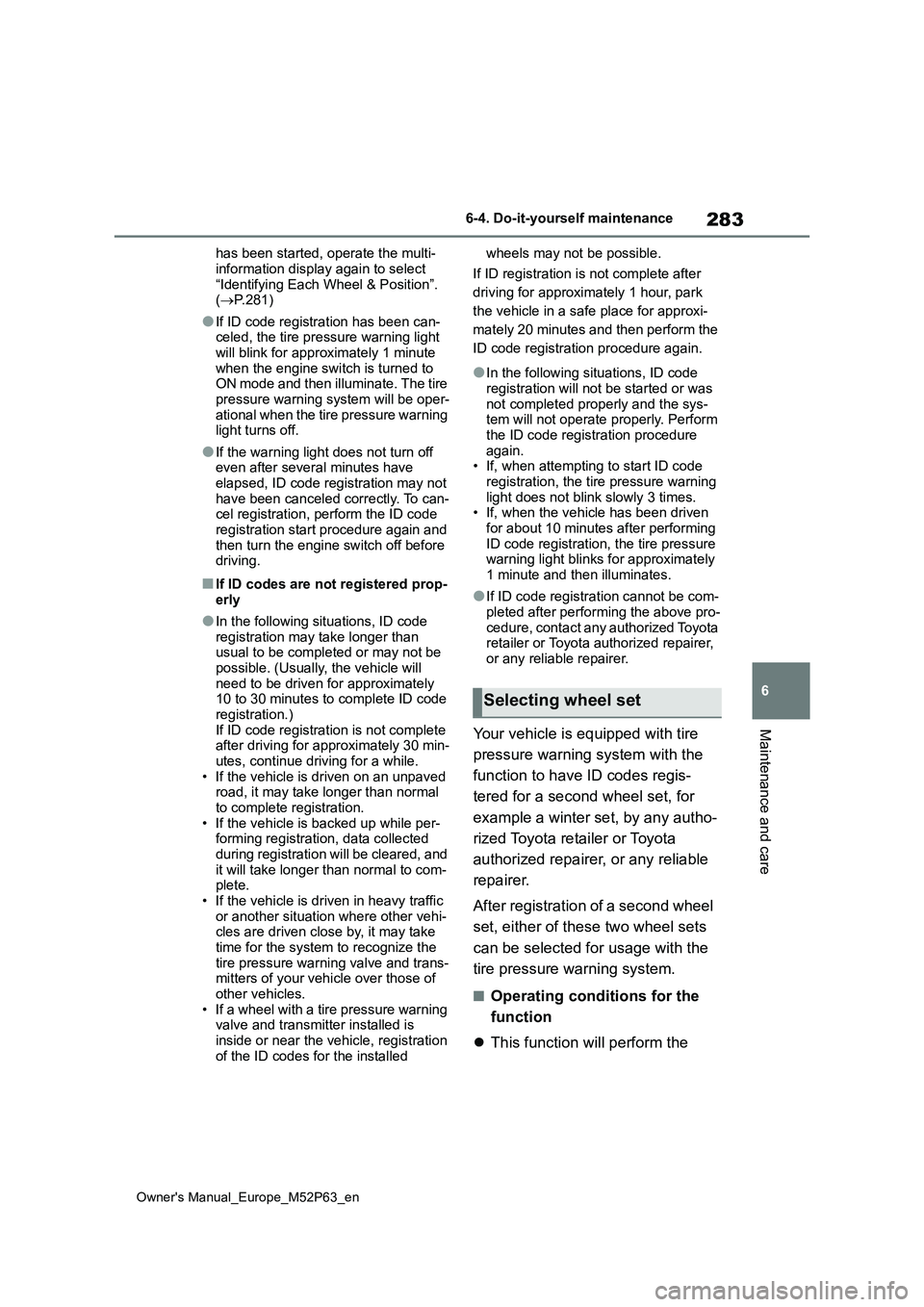
283
6
Owner's Manual_Europe_M52P63_en
6-4. Do-it-yourself maintenance
Maintenance and care
has been started, operate the multi-
information display again to select “Identifying Each Wheel & Position”. ( P.281)
●If ID code registration has been can- celed, the tire pressure warning light
will blink for approximately 1 minute when the engine switch is turned to ON mode and then illuminate. The tire
pressure warning system will be oper- ational when the tire pressure warning light turns off.
●If the warning light does not turn off even after several minutes have
elapsed, ID code registration may not have been canceled correctly. To can-cel registration, perform the ID code
registration start procedure again and then turn the engine switch off before driving.
■If ID codes are not registered prop-
erly
●In the following situations, ID code
registration may take longer than usual to be completed or may not be possible. (Usually, the vehicle will
need to be driven for approximately 10 to 30 minutes to complete ID code registration.)
If ID code registration is not complete after driving for approximately 30 min-utes, continue driving for a while.
• If the vehicle is driven on an unpaved road, it may take longer than normal to complete registration.
• If the vehicle is backed up while per- forming registration, data collected during registration will be cleared, and
it will take longer than normal to com- plete.• If the vehicle is driven in heavy traffic
or another situation where other vehi- cles are driven close by, it may take time for the system to recognize the
tire pressure warning valve and trans- mitters of your vehicle over those of other vehicles.
• If a wheel with a tire pressure warning valve and transmitter installed is inside or near the vehicle, registration
of the ID codes for the installed
wheels may not be possible.
If ID registration is not complete after
driving for approximately 1 hour, park
the vehicle in a safe place for approxi-
mately 20 minutes and then perform the
ID code registration procedure again.
●In the following situations, ID code registration will not be started or was
not completed properly and the sys- tem will not operate properly. Perform the ID code registration procedure
again. • If, when attempting to start ID code registration, the tire pressure warning
light does not blink slowly 3 times. • If, when the vehicle has been driven for about 10 minutes after performing
ID code registration, the tire pressure warning light blinks for approximately 1 minute and then illuminates.
●If ID code registration cannot be com-pleted after performing the above pro-
cedure, contact any authorized Toyota retailer or Toyota authorized repairer, or any reliable repairer.
Your vehicle is equipped with tire
pressure warning system with the
function to have ID codes regis-
tered for a second wheel set, for
example a winter set, by any autho-
rized Toyota retailer or Toyota
authorized repairer, or any reliable
repairer.
After registration of a second wheel
set, either of these two wheel sets
can be selected for usage with the
tire pressure warning system.
■Operating conditions for the
function
This function will perform the
Selecting wheel set